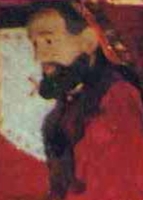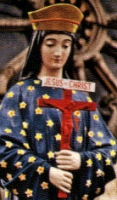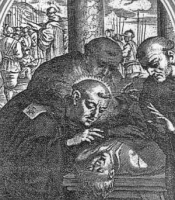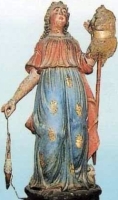| 17 January |
• yesterday • tomorrow |

• Abba Antonius
• Anthony of Egypt
• Anthony of the Desert
• Anthony the Anchorite
• Anthony the Great
• Anthony the Hermit
• Antonio Abate
• Father of Cenobites
• Father of All Monks
• Father of Western Monasticism
Following the death of his parents when he was about 20, Anthony insured that his sister completed her education, then he sold his house, furniture, and the land he owned, gave the proceeds to the poor, joined the anchorites who lived nearby, and moved into an empty sepulchre. At age 35 he moved to the desert to live alone; he lived 20 years in an abandoned fort.
Anthony barricaded the place for solitude, but admirers and would-be students broke in. He miraculously healed people, and agreed to be the spiritual counselor of others. His recommendation was to base life on the Gospel. Word spread, and so many disciples arrived that Anthony founded two monasteries on the Nile, one at Pispir, one at Arsinoe. Many of those who lived near him supported themselves by making baskets and brushes, and from that came his patronage of those trades.
Anthony briefly left his seclusion in 311, going to Alexandria, Egypt to fight Arianism, and to comfort the victims of the persecutions of Maximinus. At some point in his life, he met with his sister again. She, too, had withdrawn from the world, and directed a community of nuns. Anthony retired to the desert, living in a cave on Mount Colzim.
Descriptions paint him as uniformly modest and courteous. His example led many to take up the monastic life, and to follow his way. Late in life Anthony became a close friend of Saint Paul the Hermit, and he buried the aged anchorite, leading to his patronage of gravediggers. His biography was written by his friend Saint Athanasius of Alexandria.
His relationship with pigs and patronage of swineherds is a little complicated. Skin diseases were sometimes treated with applications of pork fat, which reduced inflammation and itching. As Anthony's intervention aided in the same conditions, he was shown in art accompanied by a pig. People who saw the art work, but did not have it explained, thought there was a direct connection between Anthony and pigs - and people who worked with swine took him as their patron.
251 at Heracleus, Egypt
• 356 at Mount Colzim of natural causes
• relics near Vienne, France
• against eczema
• epileptics; against epilepsy
• against ergotism
• against erysipelas or Saint Anthony's Fire
• against pestilence
• against skin diseases
• against skin rashes
• amputees
• anchorites
• animals
• basket makers
• basket weavers
• brushmakers
• butchers
• cemetery workers
• domestic animals
• farmers
• gravediggers
• graveyards
• hermits
• hogs, pigs, swine
• monks
• relief from pestilence
• swineherds
• Hospitallers
• Tempio-Ampurias, Italy, diocese of
• 9 cities
• asperges (exorcises evil spirits)
• baskets
• bell (exorcises evil spirits)
• blue T on his shoulder
• book (devotion to scripture and study)
• centaur
• crutch with a bell hanging from it
• crutch
• fire under his feet
• fire (represents Saint Anthony's Fire)
• flames (represents Saint Anthony's Fire)
• hog
• old man
• hermit
• pig
• rod
• satyr
• tau cross with a bell on the end
• young man distributing his wealth
• carried by demons (his defeat of worldly things and temptation)
• making baskets (the traditional source of income for early monks)
• man with a pig at his side
• Saint Anthony's cross (T or tau-shaped)
• very old monk (indicates that he was a monk from the beginning)
• with Saint Paul the Hermit
• with a devil nearby (the temptations of the world)
• with two lions, who dig Paul's grave
• YouTube PlayList
• The Temptation of Saint Anthony (audio book)
When Anthony was about eighteen or twenty years old, his parents died. Not six months after his parents' death, as he was on his way to church for his usual visit, he began to think of how the apostles had left everything and followed the Savior, and also of those mentioned in the book of Acts who had sold their possessions and brought the apostles money for distribution to the needy. This was all in his mind when, entering the church just as the Gospel was being read, he head the Lord's words to the rich man: "If you want to be perfect, go and sell all you have and give the money to the poor - you will have riches in heaven. Then come and follow me." It seemed to Anthony that it was God who had brought the saints to his mind, and that the words of the Gospel had been spoken directly to him. Immediately he left the church, and gave away to the villagers all the property he inherited, about 200 acres of very beautiful and fertile land. He sold all his other possessions, as well, giving to the poor the considerable sum of money he collected. However, to care for his sister he retained a few things. He gave himself up to the ascetic life, not far from his own home. He did manual work because he had heard the words: "If anyone will not work, do not let him eat." He spent some of his earnings on bread and the rest he gave to the poor. Seeing the kind of life he lived, the villagers and all the good men he knew called him the friend of God, and they loved him as a son and brother. - from the Life of Saint Anthony by Saint Athanasius
Saint Anthony told his monks: When, therefore, they demons come by night to you and wish to tell the future, or say 'We are the angels,' give no heed, for they lie…. But if they shamelessly stand their ground, capering and change their forms of appearance, fear them not, nor shrink, nor heed them as though they were good spirits. For the presence either of the good or evil by the help of God can easily be distinguished. The vision of the holy ones is not fraught with distraction: 'For they will not strive, nor cry, nor shall anyone hear their voice' (Matthew 12:19; Isaiah 42:2). But it comes quietly and gently that an immediate joy, gladness, and courage arise in the soul. For the Lord who is our joy is with them, and the power of God the Father. - Ambrose: Life of Saint Anthony
The days are coming when men will go mad; and, when they meet a man who has kept his senses, they will rise up against him, saying, "You are mad, because you are not like us." - Saint Anthony
https://catholicsaints.info/saint-anthony-the-abbot/

Agostino Gracchi (alias used when in the Italian Resistance)
Son of Domenico Olivelli and Clelia Invernizzi, Teresio grew up in a very religious family. His maternal uncle, Father Rocco Invernizzi, was the boy’s spiritual teacher and director. His family moved to Pavia, Italy in 1926. Studied at Ghislieri College and then in 1934 at the law school at the University of Pavia, graduating there with honors in 1938. Member of Catholic Action and a Fascist student group. Professor of administrative law at the University of Turin, Italy; there he began a personal ministry of caring for the poor and orphaned. He wrote a number of articles on the law, social conditions and current events, and won an oratory competition in Trieste, Italy with a thesis on human dignities for all people, regardless of race.
He volunteered to fight in the Spanish Civil War in 1936. Studied in Berlin, Germany from 1939 to 1941, and spoke fluent German. Volunteered to fight on the Russian front in 1941, but was injured by frostbite. His experiences in war turned him against Fascism, and he refused to swear allegiance to the Italian Social Republic government in 1943. For this, he was deported to Innsbruck, Austria on 9 September 1943, but managed to return to Milan, Italy on 20 October 1943. There he founded an underground newspaper that promoted Christianity and Christian alteratives to Facism. Due to acts like the deportation of Jews, Teresio gave up all thoughts of reconciliation with Facism, and began fighting in the Italian Resistance. Arrested on 27 April 1944 in Milan, he was imprisoned in a series of prisons, and routinely tortured by the Nazis, he was known for sharing his meagre rations with other prisoners, and treating their injuries. At one point he was imprisoned with and befriended Blessed Odoardo Focherini. Beaten to death for trying to defend a Ukranian prisoner. Posthumously awarded the Medal of Military Valor.
7 January 1916 at Bellagio, Como, Italy
• beaten to death by a guard on 12 January 1945 at Hersbruck, Nürnberger Land, Germany
• cremated at the Hersbruck camp and his ashes dumped in a common grave
• 14 December 2015 by Pope Francis (decree of heroic virtues)
• 16 June 2017 by Pope Francis (decree of martyrdom)
• 3 February 2018 by Pope Francis
• beatification recognition celebrated at Palazzetto di Vigevano, Vigevano, Italy presided by Cardinal Angelo Amato
https://catholicsaints.info/blessed-teresio-olivelli/

Roseline, Roselyne, Rosalinde
Born to an ancient and noble family; daughter of Count Arnaud. As a child, Rosalina was noted for her charity to the poor, often slipping away to give food to beggars outside the family castle. Her father, seeing that she was giving away expensive meals, ordered her to stop. Saddened, she obeyed for about a week, but the sight of the beggars at the castle door was too much for her. Late one night, she filled her apron with food, and started toward the doors. Her father caught her, and demanded to know what she carried; when she opened the apron, it was filled with roses. He immediately ordered the cooks to feed everyone at the door.
She became a Carthusian nun, entering the monastery of Bertrand in the diocese of Gap, France. Prioress of Celle-Roubaud in Provence, France. Her mother joined the order with her, and her brother built a church for their house.
Rosalina had frequent visions, the gift of reading hearts, and other mystical phenomena. Her brother Hélian fought and was captured in the Crusades. Legend says he was freed from his chains and led safely home across the seas by a vision of Rosalina who appeared to him in a cloud of roses.
1267 in a castle at Villeneuve, France
• tomb of Blessed Rosalina of Villeneuve
• 17 January 1329
• buried at Celle-Roubaud, Provence, France
• body incorrupt
• relics translated in 1607 to a chapel devoted to her
• tomb became a scene for miracles
1851 by Pope Blessed Pius IX (cultus confirmed)
Draguignan, France
https://catholicsaints.info/blessed-rosalina-of-villeneuve/

21 May as one of the Martyrs of the Mexican Revolution
Seminarian at Guadalajara, Mexico. Ordained in 1911. Priest at several parishes, including Tecolotlan, Jalisco. Noted for his combination of pastoral work with his parishioners and the sick, and for his organzational and administrative skills. When anti-religious laws were promulgated, he celebrated Mass in private homes. Arrested on 17 January 1927 while preparing to celebrate Mass on a farm. Martyr.
19 September 1886 at Zapopán, diocese of Guadalajara, Jalisco, Mexico
• hanged from a mesquite tree on 17 January 1927 at Tecolotlan, Jalisco, Mexico
• corpse mutilated and left hanging as a warning
• relics translated to Cocula, Jalisco in 1934
21 May 2000 by Pope John Paul II during the Jubilee of Mexico
I pardon you, and my Father God pardons you, and long live Christ the King! - Saint Jenaro's dying words
https://catholicsaints.info/saint-jenaro-sanchez-delgadillo/

• Enrico of Asti
• Henry...
Born to the nobility. Papal auditor. Bishop of Negroponte. Papal legate in Asia Minor where he worked for the union of Greek and Latin Churches. Patriarch of Constantinople in 1339. Negotiated an alliance between King Hugh IV of Cyprus and the Knights Hospitaler against the Turks in 1342. Pope Clement VI appointed him papal legate in the crusade against Smyrna. Martyred while celebrating Mass.
• beheaded on 17 January 1345 in Smyrna, Turkey
• re-interred in the church of San Francesco in Asti, Italy in 1392
• during the transport, the urn containing his relics was miraculously saved from being lost in a storm; this led to him being known as a "saint of the water", and his patronage when water needs to be controlled, either more or less
• re-interred under the altar in the Cathedral of Santa Maria Assunta in Asti in 1801
• against drought
• against flood
https://catholicsaints.info/blessed-enrico-comentina/
Born to a wealthy family, and may have been a member of the nobility. Pilgrim to Rome, Italy. Parish priest in Michaelsbuch, Germany for over 50 years. Founded the Benedictine Metten Abbey in Bavaria, Germany. Uncle of its first abbot, Blessed Utto of Metten.
720 in Bavaria (in modern Germany)
c.802 of natural causes
25 August 1909 by Pope Saint Pius X (cultus confirmed)
• priest surrounded by birds
• pilgrim surrounded by birds
Such was his kindness of heart, that he used to buy the little birds caught by the peasants, in order to set them free. He never allowed his servants to work in the fields or woods, if bad weather threatened. He valued, above everything, peace and concord, and kept the peace among his parishioners as far as he possibly could. - from "The Little Bollandists" by Monsignor Paul Guérin, 1882
https://catholicsaints.info/blessed-gamelbert-of-michaelsbuch/

17 January 1871
approval of diocesan bishop
During the Franco-Prussian War, German troops approached the town of Pontmain, France and the villagers there prayed for protection. On the evening of 17 January 1871, Mary appeared in the sky for several minutes over the town. She wore a dark blue dress covered in stars, carried a crucifix, and below her were the words Pray please. God will hear you soon. My son lets Himself be touched. That night the German army was ordered to withdraw, and an armistice ending the war was signed eleven days later on 28 January.
https://catholicsaints.info/our-lady-of-pontmain/

• Pius of Bourges
• Sulpice of Bourges
• Sulpicius the Pious
Born wealthy. Decided young to live celibately, and devoted himself to charity. Bishop of Bourges, France in 624. Spiritual teacher of Saint Remaclus. He became known for his personal piety and austerity, and such a good example that he is reported to have converted his entire diocese. Fought for the rights of his people against King Dagobert's minister, Lullo. Attended the Council of Clichy in 627. Late in life he resigned his see to devote himself to prayer and service to the poor.
647 of natural causes
https://catholicsaints.info/saint-sulpicius-of-bourges/
Julian the Ascetic
• 24 January (Greek Church)
• 18 October (Greek Menaea)
Hermit in a cave in Mesopotamia on the banks of the Euphrates near Edessa, and then on Mount Sinai. Legend says he ate only once a week. Ministered to and encourged Christians persecuted by Julian the Apostate. Enemies proclaimed that Julian was a follower of Arianism. He travelled to Antioch in 372, made several public speeches against the heresy - then returned to his cave where he lived the rest of his life. A brief biography of Julian was written by Saint John Chrystostom.
Mesopotamian
377 of natural causes
https://catholicsaints.info/saint-julian-sabas-the-elder/
Born to the nobility, she was Countess of Cappenberg in modern Germany. Sister of Blessed Godfrey of Cappenberg and Blessed Otto of Cappenberg. When the family turned their estate over to the Premonstratensians and turned the castle lands into a monastery, Beatrix became a Premonstratensian nun there.
c.1100 in Cappenger castle, Cappenberg, Selm, North Rhine-Westphalia, Germany
https://catholicsaints.info/blessed-beatrix-of-cappenberg/
Nennidhius, Ninnidh, Ninnaid
6 January as one of the Twelve Apostles of Ireland
Born to the Irish nobility, Ninnian was early drawn to religious life. Spiritual student of Saint Fiechus of Leinster and of Saint Finnian of Clonard. Hermit on Inis-muighe-samb in Lake Erne. His reputation for learning and personal piety attracted many spiritual students to the island.
Irish
https://catholicsaints.info/saint-nennius/

Fifth-century woman. Several ancient chapels and churches in the area of Poitiers, France are dedicated to her, and some art-work associates her with sheep, wool and spinning, but no certain information about her has survived.
near Loudon, diocese of Poitiers, France
https://catholicsaints.info/saint-neosnadia/
Mildgith, Milgitha, Milgithe, Mildgyth
Born a princess, the daughter of Merewalh, King of Mercia, and Saint Ebbe in Thanet. Sister of Saint Milburga and Saint Mildred of Thanet. Benedictine nun, receiving the veil from her mother at Minster on the Isle of Thanet. Abbess of a Northumbrian convent.
c.676 of natural causes
https://catholicsaints.info/saint-mildgytha/
Richimirus, Rigomer
Benedictine monk. With a group of disciple brother monks, and with the support of the bishop of Le Mans, France, he founded the Benedictine monastery now known as Saint-Rigomer-des-Bois in the Loire Valley of France, and served as its first abbot.
c.715 of natural causes
https://catholicsaints.info/saint-richimir/
• Molaise of Devenish
• Laserian
Priest in Kilmolash, Ireland who helped convert the people in the Inishlounaght region.
c.500 in Ireland
c.560 in Ireland of natural causes
https://catholicsaints.info/saint-molaise-by-kilmolash/
Benedictine monk. Founded the monastery of Saint Zeno at Isen, Bavaria, Germany in 752. Bishop of Freising (near Munich), Germany in 764.
• 764 of natural causes
• relics at the monastery at Isen, Germany
https://catholicsaints.info/blessed-joseph-of-freising/
Marcelo
Bishop of Die, province of Lugdunense, Gaul (in modern France). Exiled by Arian king Eurico for defending orthodox Christianity.
510 of natural causes
https://catholicsaints.info/saint-marcellus-of-die-17-january/
Triplet brother of Saint Speusippus and Saint Eleusippus; grandson of Saint Leonilla. Martyred by Marcus Aurelius. An extraordinary series of legends grew up around the family over the years.
Langres, France
https://catholicsaints.info/saint-meleusippus/
Triplet brother of Saint Speusippus and Saint Meleusippus; grandson of Saint Leonilla. Martyred by Marcus Aurelius. An extraordinary series of legends grew up around the family over the years.
Langres, France
https://catholicsaints.info/saint-eleusippus/
Triplet brother of Saint Eleusippus and Saint Meleusippus; grandson of Saint Leonilla. Martyred by Marcus Aurelius. An extraordinary series of legends grew up around the family over the years.
Langres, France
https://catholicsaints.info/saint-speusippus/
Benedictine monk at Saint Andrew's monastery on the Coelian Hill, Rome, Italy under abbot Saint Gregory the Great who later wrote about him. Miracle worker.
c.590 of natural causes
https://catholicsaints.info/saint-anthony-of-rome/
Benedictine monk at Saint Andrew's monastery on the Coelian Hill, Rome, Italy under abbot Saint Gregory the Great who later wrote about him. Miracle worker.
c.590 of natural causes
https://catholicsaints.info/saint-john-of-rome/
• Achilleus
• one of the Flowers of the Desert
Fourth century desert hermit in Egypt for decades. Friend of Saint Amoes of Sketis.
https://catholicsaints.info/saint-achillas-of-sketis/
Grandmother of Saint Speusippus, Saint Eleusippus and Saint Meleusippus. Martyred by Marcus Aurelius. An extraordinary series of legends grew up around the family over the years.
Langres, France
https://catholicsaints.info/saint-leonilla/
Benedictine monk at Saint Andrew's monastery on the Coelian Hill, Rome, Italy under abbot Saint Gregory the Great who later wrote about him. Miracle worker.
c.590 of natural causes
https://catholicsaints.info/saint-merulus/
one of the Flowers of the Desert
Fourth century desert hermit in Egypt for decades. Friend of Saint Achillas of Sketis.
https://catholicsaints.info/saint-amoes-of-sketis/
Hermit in a cave in the Baid desert on the Nile in Egypt. Spiritual student of Saint Anthony the Abbot.
395 of natural causes
https://catholicsaints.info/saint-pior/
Genou
Third century monk at Celle-sur-Naton, France.
https://catholicsaints.info/saint-genulfus/
Third century monk at Celle-sur-Naton, France.
https://catholicsaints.info/saint-genitus/
CatholicSaints.Info Portable Edition